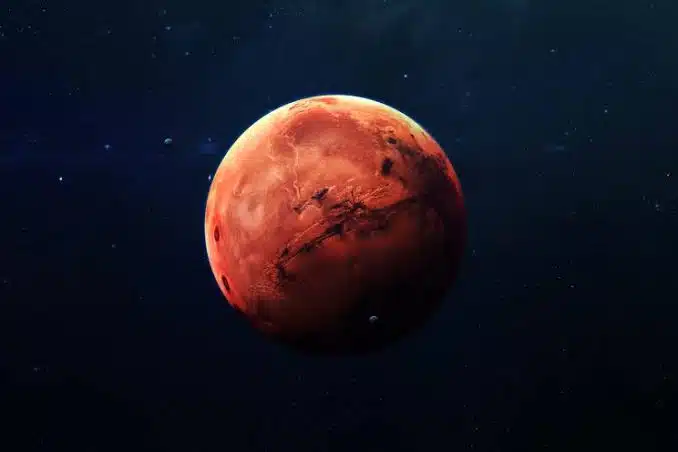Life on Mars has always been a far-sighted
yet achievable task for scientists.
And now it may just come true and mars
offer an example of the damage
that can occur to life itself.

(Source: CBSNews)
Scientists have warned us for decades about various deadly impacts of climate change that are human-caused on Earth. And some recent studies by scientists show that Life on Mars may not just be a theory or process that needs to be achieved it can be a fact too. As signs of gases on mars could be like earth’s environment because of the greenhouse gas effect and likely to have life thriving environment.
Scientists in New Study

Approximately, 3.7 to 4.1 billion years ago the environment on mars was more like earth then as compared to now, favorably, specifically, simple microbial (single-celled organisms) that usually eat up hydrogen, Carbon dioxide, and released Methane.
Scientists on further research also found out that this method of consumption could also be what may have led Life on Mars to Conk due to sudden climate changes.
In a study in the journal Nature Astronomy, Published by Springer Nature Sharedl on 10th October, they produced so much methane waste that it may have led to a “global cooling event” (imminent cooling effects of a planet due to excesses amount of gasses), these conditions may have ended potential warm conditions which may have compromised the ability for life to thrive or evolve on Mar’s surface.
Life on Mars Model Study and FAQs

Many questions arise from it, one of the most basic is – How did they come to such a discovery? Scientists and researchers from the University of Arizona created such hypothetical scenarios and environments of the Marsian Ecosystem, using various models of Mars’s crust, atmosphere, and climate as well as an ecological model of methane-producing microbes.
What was the result of the research and these experiments? They found out that early mar (3 to 4 billion years ago) had warmer and wetter in simpler words more habitable conditions than known today, making hydrogen initially liberal in Mars’s environment.
If Mars had single-celled microbes fed and conditions, why do mars not have life and multicellular organisms? Yes, Such conditions would provide an “Ample supply” of food for single-celled organisms but as microbes ate food for 4 billion years and released methane which led to cold dry, and inhabitable conditions were created for life to thrive or evolve into multicellular organisms(organisms which evolve from single-cell organisms and is made up of multiple numbers and types of cells). According to a press release from the University of Arizona.
University professor and study author Regis Ferriere said, “We may think Mars was way cooler than earth at the time, but not as nearly cold as now, with the temperature falling a bit above the freezing point of water,”
He also later added, “While current Mars has been described as an ice-covered planet in dust, we imagine early Mars as a rocky planet with permeable crust, soaked in liquid water that formed rivers, lakes, and even oceans and seas.”
Regis Ferriere and his team made a model of Mars’s crust, complete with rock and salty water and various atmospheric gases such as hydrogen and carbon dioxide with other greenhouse gases. Scientists said that, in such an environment, microbes could have thrived and populated in the “Upper level of Mar’s crust.”
Boris Sauterey, the lead author of the study said, “That thriving population could not last as the microbes’ releasing methane for a hundred thousand years completely changed the mars environment as the Red planet experienced Global cooling.”
He later added. “The cooling was brought on by the greenhouse gas effect. Hydrogen and Carbon dioxide (CO2) supported warmth on the planet but slowly but surely methane was taking hydrogen’s place and heat-trapping became more difficult allowing the planet to be cold and dry. And for the moment it is hard to say how long mars would have been habitable.”
Earth on Life and Mars: Leading to Same fate?

The Further study does note that the modeling underestimates the Global Cooling effect as it does not consider the fact the ability of surfaces to reflect life as the more the ice is the more of the Sun’s Rays get reflected increasing the cooling process in a planet.
And that process is also the main reason that contributed to the earth’s warming as sea ice melts and increases the number of sun’s rays absorbed in deep dark oceans causing a rapid increase in temperature.
According to a study, “This simple feedback could have amplified the direct atmospheric impact of methanogenesis on Mars climate and triggered a global glaciation.”
The study also suggests, “That this effect warrants further development of Life on Mars project and the mechanism in and itself points to various possibilities that habitability on Mars is indeed possible.”
Though the scenarios of earth and mars are different as Earth’s atmosphere is made of nitrogen with a percentage of oxygen, and similar in ways as the greenhouse effect is seen here too.
Unlike Mars, the molecules on earth interact differently and because of that methane is produced on earth, trapping the heat from Sun on the planet itself. The greenhouse gas effect is different on earth also as the reason for the effect is the burning of fossil fuels and not microbes releasing methane.
(With inputs from Multiple Media Outlets)
Read More at: – Change-path-Asteroid-has-been-successful-by-Nasa













